The name magnolia brings to mind beautiful perfect white flowers, and a perfumed scent. The southern magnolia tree is a romantic sight and a specimen bound to make any gardener feel proud. There are many lovely varieties that offer different shapes and sizes, including a dwarf variety.
In our how to grow and care guide, we’ll officially introduce Magnolia grandiflora, look at the different varieties, go through some guidelines on how to care for your tree, advice on propagation, and some frequently asked questions.
More...
Family: | Magnoliaceae |
|---|---|
Genus: | |
Species: | M. grandiflora |
Common Names: | Southern Magnolia, Bull Bay, Big Laurel |
Plant type: | Tree |
Sunlight: | Full sun, partial sun |
Height: | Up to 24 metres |
Spread: | Up to 15 metres |
Soil type: | Moist but well-drained, chalk, clay, loam, sand |
Soil pH: | Acid, alkaline, neutral |
Maintenance: | Low |
Introducing the Magnolia grandiflora

The magnolia got its name from the French botanist Pierre Magnol. He loved this tree so much and ended up bringing it to Europe about 300 years ago.
The tree is actually native to North America but won over the world with its spectacular green leaves and gorgeous flowers. Part of the tree’s charm is of course that it can handle many different climates and soil types.
Southern Magnolia Plant Features
Magnolia grandiflora is evergreen and grows in a shape like a pyramid. The roots are shallow and like to spread out. The leaves of the southern magnolia are shiny and oval and can be up to 20cm long.
The flowers are also large and a similar size as the leaves. They have an attractive perfume and are a creamy white colour. The flowers end up blooming into summer so you’ll have a lengthy period to enjoy them.
After the flowers come fruits with red seeds that arrive in autumn. The fruits are also large in size and attract many birds, another wonderful benefit for your garden.
The tree can grow to a height of 24 metres and spread out around 15 metres. Magnolia grandiflora grows quickly, an amazing 60 cm a year. The tree is often used to line streets, to provide shade, and also as a windbreak.
Popular Types of Magnolia Grandiflora to Choose From
Magnolia grandiflora ‘Edith Bogue’Edith Bogue Magnolia can handle the cold really well. It grows in a pyramid shape and can reach a height of up to 9 metres. | 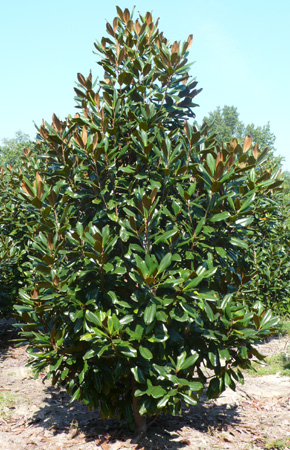 Source: tankardnurseries.com |
Magnolia grandiflora ‘Hasse’This variety grows in a column shape and can reach a height of 12 metres. | 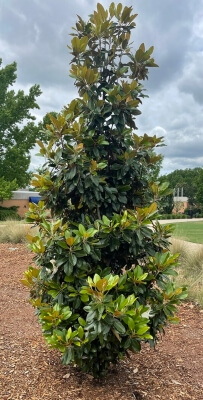 Source: plantsmap.com |
Magnolia grandiflora ‘Little Gem’This variety is a dwarf magnolia and is one of the smaller varieties. You would usually grow it as a shrub and it has a maximum height of 7.5 metres. For more on this variety, see our Little Gem Magnolia growing guide. | 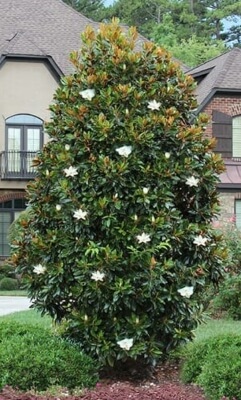 Source: thetutuguru.com.au |
Magnolia grandiflora ‘Bracken's Brown Beauty’This is another variety that handles winter well. It grows very compact and to a height of about 9 metres. | 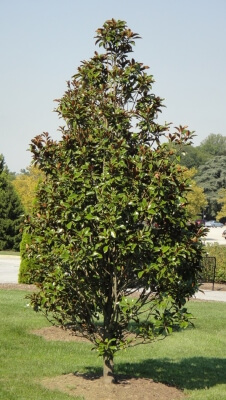 Source: plantexplorer.longwoodgardens.org |
Magnolia grandiflora ‘Claudia Wannamaker’This variety grows big and rounded. It also produces the most flowers of all the varieties. | 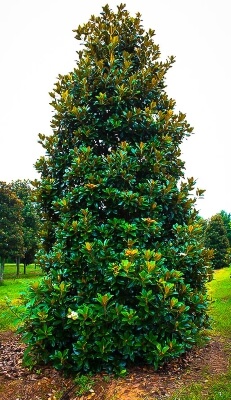 Source: thetreecenter.com |
Magnolia grandiflora ‘D.D. Blanchard’This variety has big leaves that are dark green on the one side and brown on the other. The tree can grow to 15 metres high and has a wide canopy. This makes the tree great for shade. | 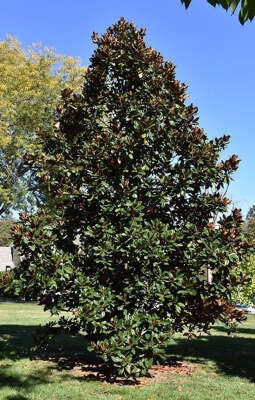 Source: calloways.com |
Magnolia grandiflora ‘Teddy Bear’This variety is upright growing and features a very compact, conical habit with dark green oval leaves. Most trees will reach about 2 to 3 metres wide and 3 to 6 metres tall. Learn how to grow Magnolia ‘Teddy Bear’ by reading our in depth growing guide. |  Source: thetutuguru.com.au |
Magnolia grandiflora ‘Edith Bogue’

Source: tankardnurseries.com
Edith Bogue Magnolia can handle the cold really well. It grows in a pyramid shape and can reach a height of up to 9 metres.
Magnolia grandiflora ‘Hasse’

Source: plantsmap.com
This variety grows in a column shape and can reach a height of 12 metres.
Magnolia grandiflora ‘Little Gem’

Source: thetutuguru.com.au
This variety is a dwarf magnolia and is one of the smaller varieties. You would usually grow it as a shrub and it has a maximum height of 7.5 metres. For more on this variety, see our Little Gem Magnolia growing guide.


Get Your Free Guide:
Master Growing Australian Natives eBook
A Must Have Complete Guide for Every Australian Garden
Get Your Free Guide:
Master Growing Australian Natives eBook
A Must Have Complete Guide for Every Australian Garden
Magnolia grandiflora ‘Bracken's Brown Beauty’

Source: plantexplorer.longwoodgardens.org
This is another variety that handles winter well. It grows very compact and to a height of about 9 metres.
Magnolia grandiflora ‘Claudia Wannamaker’

Source: thetreecenter.com
This variety grows big and rounded. It also produces the most flowers of all the varieties.
Magnolia grandiflora ‘D.D. Blanchard’

Source: calloways.com
This variety has big leaves that are dark green on the one side and brown on the other. The tree can grow to 15 metres high and has a wide canopy. This makes the tree great for shade.
Magnolia grandiflora ‘Teddy Bear’

Source: thetutuguru.com.au
This variety is upright growing and features a very compact, conical habit with dark green oval leaves. Most trees will reach about 2 to 3 metres wide and 3 to 6 metres tall.
Learn how to grow Magnolia ‘Teddy Bear’ by reading our in depth growing guide.
Growing Magnolia grandiflora in Australia
The southern magnolia is quite easy to grow. When you choose a planting spot, try to ensure they have a bit of shelter from the wind, and also space to spread out as they grow.
The tree does make a bit of a mess when the leaves fall off and this is something to keep in mind when choosing where to plant it. You could always use the leaves as mulch so it does have a silver lining.
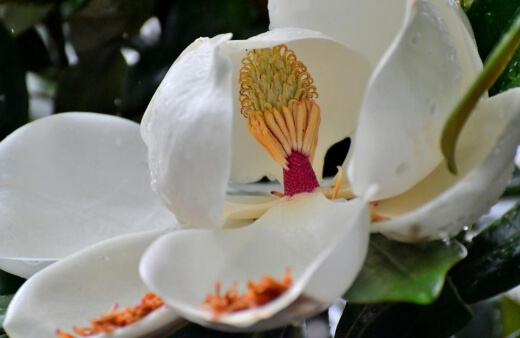
Southern Magnolia Best Growing Conditions
Sunlight
The southern magnolia likes part shade the best and this is truer if the soil is on the dry side. When the tree has matured it can then handle full sun along with a richer and moist soil. Four hours of sunlight a day is perfect.
Best Soil to Use
When thinking about soil for your Magnolia grandiflora, you want to go with soil that is moist and well-draining. The soil should also be loamy and acidic to keep your tree happy.
These are the ultimate conditions but luckily southern magnolia can actually handle a variety of soils and pH levels.
Climate
Your southern magnolia likes a subtropical climate and nothing too extreme in terms of temperature. It doesn’t do well with frost.
How to Propagate Magnolia grandiflora
Propagating Southern Magnolia from Cuttings
Choose a cutting that is about 15cm and it should have a few leaves on it too. Aim to take a cutting sometime during the summer. Cut straight directly above a node and then you can remove any leaves below that.
Dip the tip of the cutting in a rooting hormone and plant it about 10cm deep in a moist and well-draining mixture. Be cautious with the roots of the cutting when you do the transplanting as they are very fragile.
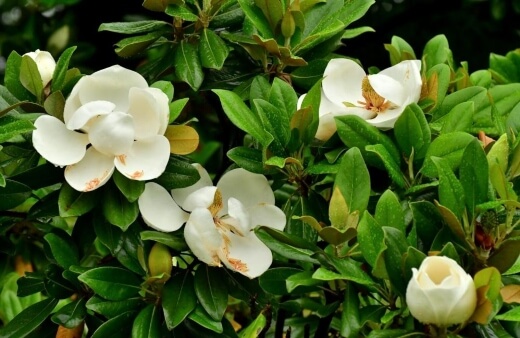
Magnolia grandiflora Propagation from Seed
Once you’ve collected cones, you can dry them until you have your seeds. Start off by soaking the seeds in warm water for about 2 days. This is to remove the coating of the seed.
You can then dry off the seeds ready for planting. Use a mixture of peat and vermiculite (or sand) and place your seeds with the mix in a plastic bag. Pop it into the fridge for 2 months. It can take about 18 months for the seeds to germinate.
When your seedlings are big enough, you can then move them to an area that has slight shade. When the seedlings are about 15cm in height, you can plant them in the garden with mulch and be sure to offer some protection in winter.
How to Care for Southern Magnolia
Watering Schedule
Magnolia grandiflora is drought tolerant with the right soil and if the roots have enough space to grow. As a guideline, when you first plant the tree you can water weekly.
When the tree gets older, you can then let the rainfall help you decide how often to water. It’s helpful to mulch around the tree but just make sure the mulch doesn’t touch the tree trunk.
What Fertiliser to Use
You can help your Magnolia grandiflora grow to be its best by fertilising in spring, summer and autumn in the first 3 years of its life. After that, the roots should be able to access the nutrients they need without the help of fertiliser.
Pruning Magnolia Grandiflora
If you feel like you want to neaten up your Magnolia grandiflora, or want to encourage a different shape, you can do some pruning once flower season is done. You’ll need to do this before winter when the branches become dormant.
Magnolia grandiflora Pests and Diseases
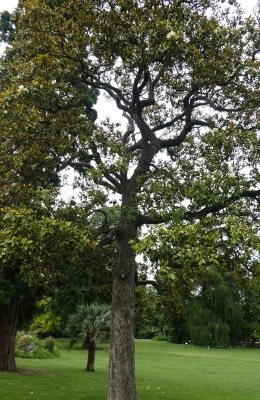
Southern magnolia don’t have many problems when it comes to pests and diseases. As always, the right care of the plant makes all the difference.
Here are two things you can look out for that might pop up:
Leaf Spot
Leaf spots show up in different shapes, sizes and colours and you will usually find them on the lower parts of the tree. The spots might be on one side or both sides of the leaves. As a guideline, the small spots mean a newer infection.
The bigger spots are an indication of older ones. You might actually see the fungal spores in the middle of the spots. Another sign of leaf spot is when the leaves start dropping off before they’re ready or if the plant loses the majority of its leaves.
When it comes to treating leaf spot, you’ll need to prune off the leaves that are infected and then treat the leaves with something like neem oil or an alternative fungicide. While the plant is in recovery, try not to get water on the leaves.
Verticillium wilt
Verticillium wilt is a disease caused by a fungus living in the tree tubes which transport water. The fungus causes a blockage in the tubes, meaning the tree can’t get water and then starts to wilt.
Your tree also ends up being poisoned by toxins which the fungus produces. The first sign of this disease is usually when the edges of the leaves start to wilt. This usually happens to the older leaves first.
Unfortunately there is no fungicide to treat verticillium wilt but there are a few things you can do to try and promote tree health. Pruning your tree is important, along with the right amount of water and supercharging with nutrients through fertilising.
Magnolia grandiflora Frequently Asked Questions
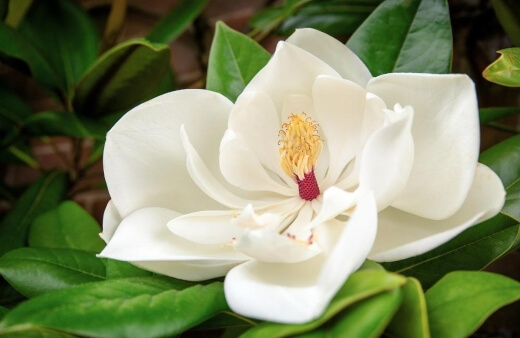
What kind of health issues can Magnolia grandiflora be used to treat?
This plant is known for its health benefits to treat things like high blood pressure, muscle spasms, inflammation, headaches and fever, to mention a few. Both the bark and the flowers are used for medicinal reasons.
Can you eat the southern magnolia?
Not many people know that the flowers of the Magnolia grandiflora can be eaten. The flavour is very strong though and eating them raw is not the best – generally they are eaten pickled.
Does the Magnolia grandiflora have any kind of symbolic significance?
The magnolia flower is generally known to be a symbol of endurance, purity and love.
What makes the Magnolia grandiflora so popular?
Their flowers look a bit like tulips and they are really big when they have fully opened. Historically, magnolias are one of the earliest known flowering plants.
These trees were around even before bees and that’s why the Magnolia grandiflora is pollinated by beetles. The flowers produce pollen, not nectar, and that’s what the beetles feed on.
Perhaps the kind of shopping trip that gets you excited is one where you get to shop for all things gardening related. It’s possible that nobody understands your love and enthusiasm for power tools and hoses.
Don’t worry, we’ve got you covered. If you need some advice before you go shopping for your next garden item, have a look through our gardening tools and products section.
In need of more gardening inspiration and advice? Sign up for our Aussie Green Thumb newsletter.
Enjoy Gorgeous Summer Shade with Magnolia grandiflora in Your Garden
Whatever the size of your garden, there is likely to be a variety of Magnolia grandiflora that works for you. Whether you want a more compact shape, something small, or a very statement tree, the southern magnolia can offer up an inviting display of grand leaves and gorgeous flowers.
It can take up to 7 years for the Magnolia grandiflora to flower but it really is worth the wait. The tree is generous with its flowers, and continues to offer blooms even into the start of autumn and all through the summer.
Just imagine gorgeous summer days under the shade of your southern magnolia, with a cool drink, and taking in the divine perfume of the flowers. There is something very romantic about it.
Southern magnolia has earned itself a reputation the world over for being classy and certainly in demand. Investing in your own Magnolia grandiflora will no doubt bring you lots of joy and we’re giving it our green thumbs up.
Published on July 30, 2022 by Maisie Blevins
Last Updated on October 4, 2025




